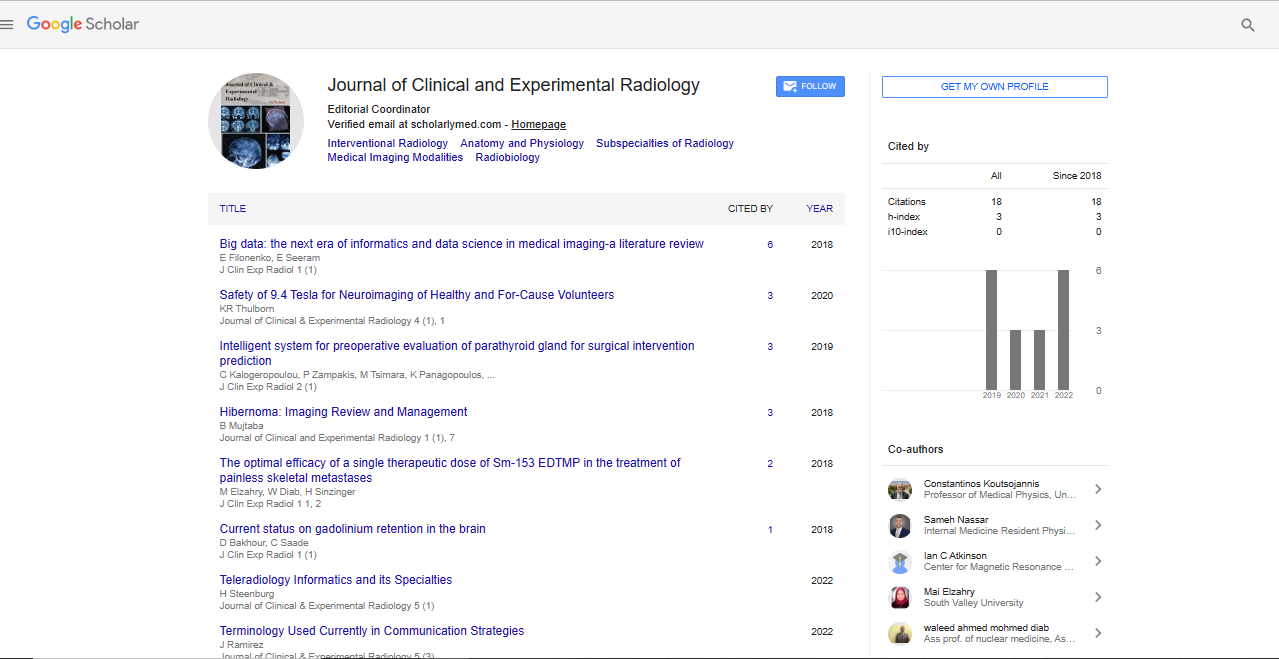Opinion Article, J Clin Exp Radiol Vol: 6 Issue: 4
Radiation Chemistry: Resolving Molecular Transformations through Ionizing Radiation
Maets Sarota*
1Department of Radiological Sciences and Medical Imaging, California State University, Long Beach, Stockholm, Sweden
*Corresponding Author: Maets Sarota,
Department of Radiological Sciences and
Medical Imaging, California State University, Long Beach, Stockholm, Sweden
E-mail: maesarota@gmail.com
Received date: 24 November, 2023, Manuscript No. JCER-24-124146;
Editor assigned date: 28 November, 2023, PreQC No. JCER-24-124146 (PQ);
Reviewed date: 14 December, 2023, QC No. JCER-24-124146;
Revised date: 21 December, 2023, Manuscript No. JCER-24-124146 (R);
Published date: 28 December, 2023, DOI: 10.4172/jcer.1000154
Citation: Sarota M (2023) Radiation Chemistry: Resolving Molecular Transformations through Ionizing Radiation. J Clin Exp Radiol 6:4.
Description
Radiation chemistry is a interesting branch of science that explores the chemical changes induced in matter by ionizing radiation. This manuscript provides a comprehensive overview of the principles, processes, and applications of radiation chemistry. Understanding the intricate molecular transformations brought about by radiation is crucial for various fields, including medicine, industry, and environmental science.
Radiation chemistry search into the chemical reactions initiated by the interaction of ionizing radiation with matter. This interaction leads to the formation of highly reactive species, such as free radicals, ions, and excited molecules, which subsequently drive a cascade of chemical transformations. The study of radiation chemistry has broad applications, ranging from the design of advanced materials to environmental decontamination.
Ionizing radiation sources
Ionizing radiation sources, such as gamma rays, x-rays, and energetic particles, serve as catalysts in radiation chemistry. Gamma rays and x-rays, emitted during radioactive decay or generated artificially, possess the energy needed to liberate electrons from atoms, initiating a series of chemical events. Additionally, charged particles, such as electrons, protons, and alpha particles, contribute to radiationinduced chemistry through direct ionization and excitation.
Radiolysis and free radical formation
The primary outcome of ionizing radiation is the breaking of chemical bonds, leading to the generation of free radicals. Radiolysis, the decomposition of molecules by radiation, results in the formation of reactive species with unpaired electrons. These free radicals play a pivotal role in subsequent chemical reactions, influencing the overall radiation chemistry of a system.
Mechanisms of radiation-induced reactions
Radiation-induced chemical reactions can be classified into direct and indirect mechanisms.
Direct effects: Direct effects involve the interaction of ionizing radiation directly with the target molecules, leading to bond breakage and the formation of free radicals. This mechanism is more prominent in simple systems and gases.
Indirect effects: Indirect effects occur when radiation interacts with surrounding molecules, primarily water, producing highly reactive species that subsequently participate in chemical reactions. Water radiolysis, resulting in the formation of hydroxyl radicals and hydrated electrons, is a crucial indirect effect influencing biological and environmental systems.
Applications of radiation chemistry
Radiation chemistry finds diverse applications in several fields:
Polymerization and material science: Radiation-induced polymerization is employed to synthesize advanced materials with tailored properties. Cross-linking of polymers enhances their mechanical strength and thermal stability, contributing to the development of materials used in medical devices, packaging, and aerospace.
Radiation processing of foods: Ionizing radiation is used to control the microbial load in food products, extending shelf life and ensuring food safety. This process, known as irradiation, helps preserve the quality of foods without significant alterations to their nutritional content.
Water treatment and environmental remediation: Radiation chemistry plays a role in the degradation of pollutants in water and soil. The use of ionizing radiation in processes such as radiolytic decomposition and advanced oxidation contributes to environmental remediation efforts.
Challenges and future directions
Despite its diverse applications, radiation chemistry poses challenges, including the potential for unintended side reactions and the need for precise control over reaction pathways. Ongoing research focuses on improving our understanding of radiation-induced processes, developing novel materials, and optimizing applications in medicine, industry, and the environment.
Conclusion
Radiation chemistry stands at the intersection of physics and chemistry, resolving the intricate molecular transformations initiated by ionizing radiation. This manuscript has provided an overview of the principles, mechanisms, and applications of radiation chemistry, highlighting its significance in various scientific and industrial domains. As research in this field progresses, new insights into the fundamental processes and innovative applications are expected to emerge, further enriching our understanding of the dynamic world of radiation-induced chemical reactions.
 Spanish
Spanish  Chinese
Chinese  Russian
Russian  German
German  French
French  Japanese
Japanese  Portuguese
Portuguese  Hindi
Hindi 